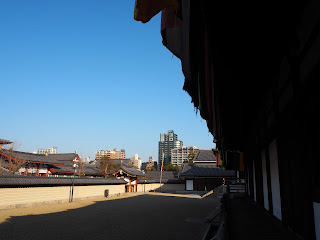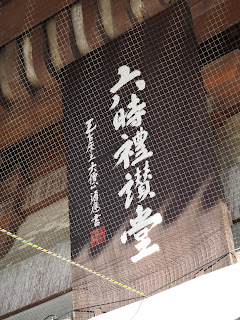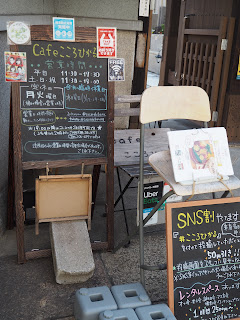Osaka 33 Kannon Pilgrimage ---In My Order--- (2)
The omicron coronavirus variant casts a shadow over my actually visiting a 33 Kannon Pilgrimage. Today, however, I made up my mind to visit some member temples of the Osaka 33 Kannon Pilgrimage since I have few chances to actually talk with anyone.
I stepped out of Tennoji Station and turned north toward Shitenno-ji Temple. To secure the number 33 with Avalokitesvara deities, the organizer of the Osaka 33 Kannon pilgrimage picked up 4 Avalokitesvara images from Shitenno-ji Temple. You may think that will save time, but the temple is large enough to wander around. First, I visited Manto-in Hall, which enshrined an eleven-faced Ekadasamukha statue. However, the hall is more known with its Arhat statue, which wears paper robe. Annually on August 10th, it changes its robe, and its followers can put the old robe their diseased parts to be healed. If you put the robe on your back 3 times, or for 3 years, you won't have someone attend your personal needs.
I walked out of the Manto-in Hall, and moved counter clockwise around the Central Temple, which was composed with 2 halls and a tower and was surrounded with its cloisters. I found Sutra Hall easily surrounded with walls, and realized that I should walk back to Taishiden to enter the enclosure, which is called Shoryo-in. I did, but was at a loss. There were 2 buildings, Taishiden and Taishiokuden, between Sutra Hall and me, and sand gardens blocked my way. Worrying over omicron coronavirus variant, I asked a lady there what to do to reach Sutra Hall. "It's open only on October 15th." said she. I just took pictures of Sutra Hall over Taishido, gardens, and walls. The hall was strictly guarded in the Shoryo-in Inner Temple.
The next counter-clockwise walk brought me to Rokuji-do Hall, which was named so because they perform prayers 6 times a day.
Finally, I moved into the Central Temple. Of course, I had to pay to get into the innermost center of Shitenno-ji Temple. The payment boosted its refreshing atmosphere even more. I visited Kon-do Hall first. I walked along its cloisters and got into Lecture Hall, which enshrined an eleven-faced Ekadasamukha statue.
I could call it a day, but the holly air in Central Temple gave me a push to go on. I walked out of Shitenno-ji Temple westward and stepped into Reinin-cho. Those who played music fot Shitenno-ji Temple used to be called reinin, and they used to live in the township. Kiyomizu-dera Temple was located there. How many Kiyomizu-dera or Seisui-ji Temples does Japan have? 30 or more? Some have just copied Kiyomizu-dera Temple in Kyoto, but you can realize Kiyomizu-dera Temple in Reinin-cho doesn't fail to live up to its name. The precincts have the only waterfall, however tiny it may be, in Osaka City. The waterfall is equipped with something like those in Kyoto, and the temple, as the matter of course, enshrines an eleven-faced Ekadasamukha statue.
To the north of Reinin-cho, Shimo-Tera-machi stretches northward along the foot of the western cliff of Uemachi Plateau, at the northernmost edge of which Osaka Castle stands. As its place name shows, many temples are located along the Matsuyamachi-suji Street. Some of them are the member temples of the Osaka 33 Kannon Pilgrimage: #33 Saisho-ji Temple, #26 Shinko-ji Temple, #27 Daikaku-ji Temple, #28 Kontai-ji Temple, and #29 Dairen-ji Temple.
Saisho-ji Temple was founded by Priest Riden in 1596. On July 15, 1595, Toyotomi Hidetsugu (1568-1595) was cornered by his uncle, Toyotomi Hideyoshi (1537-1598), and killed himself. On August 2nd, Hidetsugu's 5 children and 29 wives were killed in the Sanjo Riverbed, Kyoto. In 1596, Japan Median Tectonic Line caused great earthquakes one after another. First, in Iyo Province, Shikoku Island, on September 1, an earthquake caused many temples collapse. Second, in Bungo Province, Kyushu Island, on September 4, another earthquake caused 2 small islands to sink and killed more than 800 people. Third, in Fushimi, Kyoto, on September 5, another earthquake destroyed many temples and even a castle and killed more than 1,000 people. Either human-made or natural disasters might have driven Riden to found a temple.
Shinko-ji Temple was founded by Priest Eigyoku in 1624, a year after Tokugawa Iemitsu (1604-1651) became the third shogun of the Tokugawa Shogunate. He and his father, Hidetada (1579-1632), dissolved many clans to strengthen the power of the shogunate. This increased the number of masterless and jobless samurai and destabilized society. To re-stabilize society, Iemitsu strengthened the danka system. Every citizen was supposed to belong to a Buddhist temple. Accordingly, the number of temples increased. Eigyoku might have grabbed a business opportunity. Even generations later, the priest of the temple hasn't lost challenging spirit. the temple organizes yoga and aesthetician's classes, runs a cafe, and holds live concerts.
Daikaku-ji Temple was mentioned in the Joruri narrative song, the Love Suicide at Sonezaki, of Chikamatsu Monzaemon (1653-1725): "Even though I'm not enlightened, I rely on Daikaku-ji Temple."
Just before Kontai-ji Temple, I found a stone monument, which said Shinsen-Gumi had its Osaka Office in Manpuku-ji Temple, which was located just south to Kintai-ji Temple. Shinsen-gumi was a militia formed to maintain "the public peace of Kyoto" at the end of Edo Period, started their services as militiamen at Mibu, and stayed there for about 3 years. In those days, some of them went on business to Osaka.
Kontai-ji Temple's main hall is the oldest Pure Land Buddhism main hall in Osaka. I entered the precincts of Kontai-ji Temple and found its main hall easily. However, I found another mysterious building on my left. The building seemed to be segregated from the Kontai-ji precincts with walls. The signboard on the wall of the building says its name was Joso-ji Temple and claimed to be the #28 Temple of the Osaka 33 Kannon Pilgrimage with its "goeika" tanka poem. The Kannon-do Hall or Joso-ji Temple was said to enshrine 33 Avalokitesvara statues with its own thousand-armed Sahasrabhuja in their center.
Dairen-ji Temple was founded on March 5th, 1550, by Priest Seiyo, who was said to have been the third son of Ashikaga Yoshiharu (1511-1550), the 12th Shogun of the Ashikaga Shogunate. If so, Seiyo founded the temple to pray for the recover of his father from edema, which he suffered at the end of 1549. In spite of Seiyo's prayers, Yoshiharu died on May 4th. When his elder brother, Yoshiteru (1536-1565), the 13th Shogun, was killed by Miyoshi Yoshitsugu (1549-1573), Miyoshi Nagayasu (?-?), Miyoshi Soi (?-1569), Iwanari Tomomichi (?-1573), and Matsunaga Hisamichi (1543-1577), the priest was taken to Kyoto and was killed on the way by a certain Hirata, who was killed by the priest's page on the spot.
After visiting the temples in Shimo-Tera-machi, I approached Ikutama Shrine, around which there were a couple of more member temples: Bodai-ji Temple and Honsho-ji Temple.
Bodai-ji Temple was founded in 1597. In 1596, the Arima-Takatsuki fault zone and the Rokko-Awaji-Island fault zone slipped around Kyoto and caused Magnitude 7.5 earthquakes. In Fushimi castle alone more than 600 people were crushed to death. Even in Osaka, many houses were destroyed and soil liquefaction broke out in lowlands along rivers. Bodai-ji Temple might have been founded to pray for the comfort of the dead in the other world.
Honsho-ji Temple was founded by Priest Jokyu in 1593. In 1592, Hideyoshi invaded Korea, and, in 1593, his concubine, Chacha (1569-1615) gave birth to his only son, Hideyori (1593-1615). The foundation of the temple was sandwiched between the grief over the dead and the joy over the birth, and it is hard to know whether it was founded to grieve or to celebrate. The temple is still hard to find, sandwiched between modern buildings.
After visiting 13 temples and Ikutama Shrine, I was limping. I dragged toward Uehonmachi Station. If I take the Kintetsu Line there, I can get to JR Tsuruhashi Station, and I can enjoy Korean dishes in the Korea Town near the station. I felt my mouth water. I stood in front of the station building which was located at Uehonmachi 6 Chome. #14 Choan-ji and #15 Seian-ji Temples were located just next to Uehonmachi 4 Chome. I had only 2 blocks to walk. I felt unwilling but my foot stepped to the north for 2 blocks. The 2 blocks were a heavy burden.
For my luck, the 2 temple stood just across the street. I easily added 2 to my list of the temples I visited in the Osaka 33 Kannon Pilgrimage.
Choan-ji Tempe was founded sometime between 1573 and 1593 by Priest Hoyo (?-1607), when Oda Nobunaga (1534-1582), Toyotomi Hideyoshi (1537-1598), and Tokugawa Ieyasu (1543-1616) were still fighting hard to unify Japan. Hoyo survived the Warring States Period and died 4 years after Ieyasu was appointed as a shogun, 2 years after Tokugawa Hidetada (1579-1632) was appointed to be the second shogun, and 8 years before Toyotomi Hideyori (1593-1615) was killed by Ieyasu and Hidetada.
Seian-ji Temple was founded by Priest Seido in 1598, when Hideyoshi died.
After visiting the 2 temples, I walked east. At the 3rd traffic light, I didn't hesitate. #12 Keiden-ji Temple was just 200 meters north.
Keiden-ji Temple is at the eastern edge of Jonan-cho. Jonan literally means Castle South. The area used to be located in the south of Osaka Castle. To the east of Jonan-cho, Sanadayama-cho is in the back of Keiden-ji Temple. Sanada Yukimura (1567-1615) constructed Sanada Fortress attached to the southern border of Osaka Castle to raise his standard with 6 coins against Tokugawa Ieyasu and to defend the castle with Hideyori in it from Ieyasu in the Siege of Osaka in 1615. The 6 coins were supposed to pay for a ferry to cross the Sanzu River to go to the next world. Yukimura fought so fiercely that he became a legend. His life spun off a lot of legends and stories. Spun off heroes included the Sanada Ten Braves.
Kotoku-ji Temple was just a block north. It started as Yakushi-in Temple when Prince Shotoku (574-622) was still alive. It was revived by Gyoki (668-749) sometime between 729 and 749. By the turn of the 18th century, it was renamed Kotoku-ji, which enshrines a statue of Cundi, who usually has 16 arms and appears to be female. The Cundi statue in the temple has 3 eyes and 18 arms. As the statue outdoors looked new and modern, the original one might have been enshrined in the main hall.
Did I call it a day? I visited temples in descending order to #11. I had visited #10 Ryukai-ji Temple almost a week before. No. The #10 deity used to be enshrined in Tamatsukuri Inari Shrine before the Gods and Buddhas Separation Order by the Meiji Restoration Government in 1868. I crossed Nagahori-dori Street to the north and climbed a hill to get to the shrine. I found a tree standing in the middle of the street. It must be a holy tree.
Believe it or not, Tamatsukuri Inari Shrine was said to have been founded in 12 B.C. Human beings have inhabited in the Japanese Archipelago since 30 or 40 thousand years ago, although Archipelago itself was formed some 10 or 20 thousand years ago. "The shrine" could have been a holy place far before written history. It was revived in the 6th century.
After the shrine, I walked down the hill to JR Tamatsukuri Station. Near the station, I found the Tamatsukuri Shopping Mall, and though I might be able to find a restaurant to have late lunch. However, the mall was, as often the case today, deserted. I turned left into an alley to the station, to find it very interesting. They called it the Sanada Street and displayed the animation characters of Yukimura and the Sanada Ten Braves. I entered one of the restaurant along the alley, Omasu, and had Sanada Gozen, or Sanada Lunch Set Meal, with its side dishes displayed on a tray so as that they looked like Yukimura's standard with 6 coins. Can I go back to my everyday world with those 6 small dishes instead of the 6 coins?
Shitenno-ji Temple Manto-in Hall
Address: 1 Chome-11-18 Shitennoji, Tennoji Ward, Osaka, 543-0051
Phone: 06-6771-0066
Shitenno-ji Temple Sutra Hall
Address: 1 Chome-11 Shitennoji, Tennoji Ward, Osaka, 543-0051
Shitenno-ji Rokujireihai-do Hall
Address: 1 Chome-11-18 Shitennoji, Tennoji Ward, Osaka, 543-0051
Shitenno-ji Kon-do Hall
Address: 1 Chome-11 Shitennoji, Tennoji Ward, Osaka, 543-0051
Shitenno-ji Lecture Hall
Address: 1 Chome-11-18 Shitennoji, Tennoji Ward, Osaka, 543-0051
Kiyomizu-dera Temple
Address: 5-8 Reinincho, Tennoji Ward, Osaka, 543-0061
Saisho-ji Temple
Address: 2 Chome-2-45 Shitaderamachi, Tennoji Ward, Osaka, 543-0076
Phone: 06-6771-9180
Shinko-ji Temple
Address: 1 Chome-3-68 Shitaderamachi, Tennoji Ward, Osaka, 543-0076
Phone: 06-6771-0909
Daikaku-ji Temple
Address: 1 Chome-3-77 Shitaderamachi, Tennoji Ward, Osaka, 543-0076
Phone: 06-6771-5635
Kontai-ji Temple
Address: 1 Chome-3-88 Shitaderamachi, Tennoji Ward, Osaka, 543-0076
Phone: 06-6771-0295
Bodai-ji Temple
Address: 4-10 Ikutamacho, Tennoji Ward, Osaka, 543-0071
Phone: 06-6771-8691
Honsho-ji Temple
Address: 3-6 Ikutamachō, Tennoji Ward, Osaka, 543-0071
Ikutama Shrine
Address: 13-9 Ikutamacho, Tennoji Ward, Osaka, 543-0071
Phone: 06-6771-0002
Dairen-ji Temple
Address: 1 Chome-1-30 Shitaderamachi, Tennoji Ward, Osaka, 543-0076
Phone: 06-6771-0739
Choan-ji Temple
Address: 5-13 Jonanteramachi, Tennoji Ward, Osaka, 543-0017
Phone: 06-6761-4022
Seian-ji Temple
Address: 6-29 Jonanteramachi, Tennoji Ward, Osaka, 543-0017
Keiden-ji Temple
Address: 6-31 Esashimachi, Tennoji Ward, Osaka, 543-0016
Phone: 06-6761-5277
Kotoku-ji Temple
Address: 2-17 Esashimachi, Tennoji Ward, Osaka, 543-0016
Phone: 06-6761-7040
Tamatsukuri Inari Shrine
Address: 2 Chome-3-8 Tamatsukuri, Chuo Ward, Osaka, 540-0004
Phone: 06-6941-3821
Katsushun Omasu
Address: 3-2 Tamatsukuri Motomachi, Tennoji Ward, Osaka, 543-0014
Phone: 050-5486-0632
































































































0 Comments:
Post a Comment
<< Home